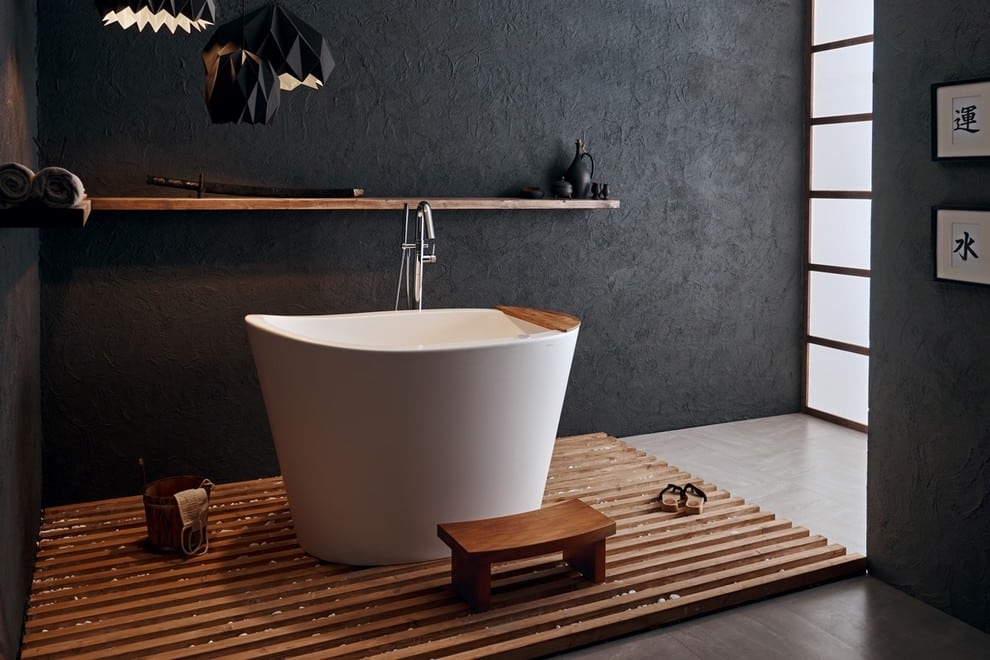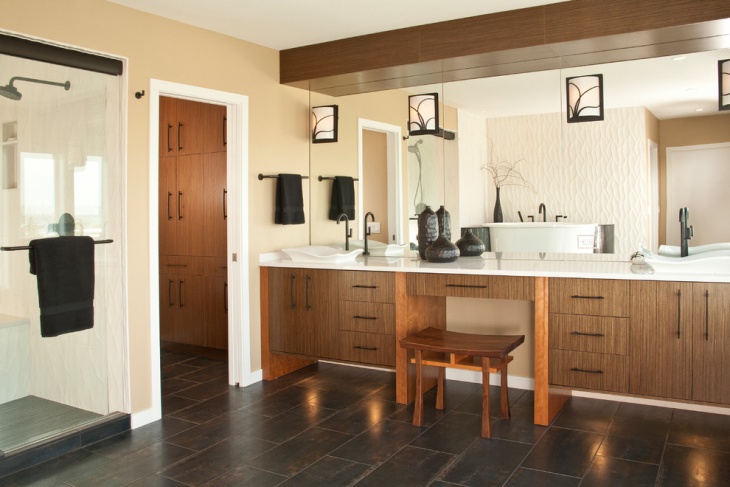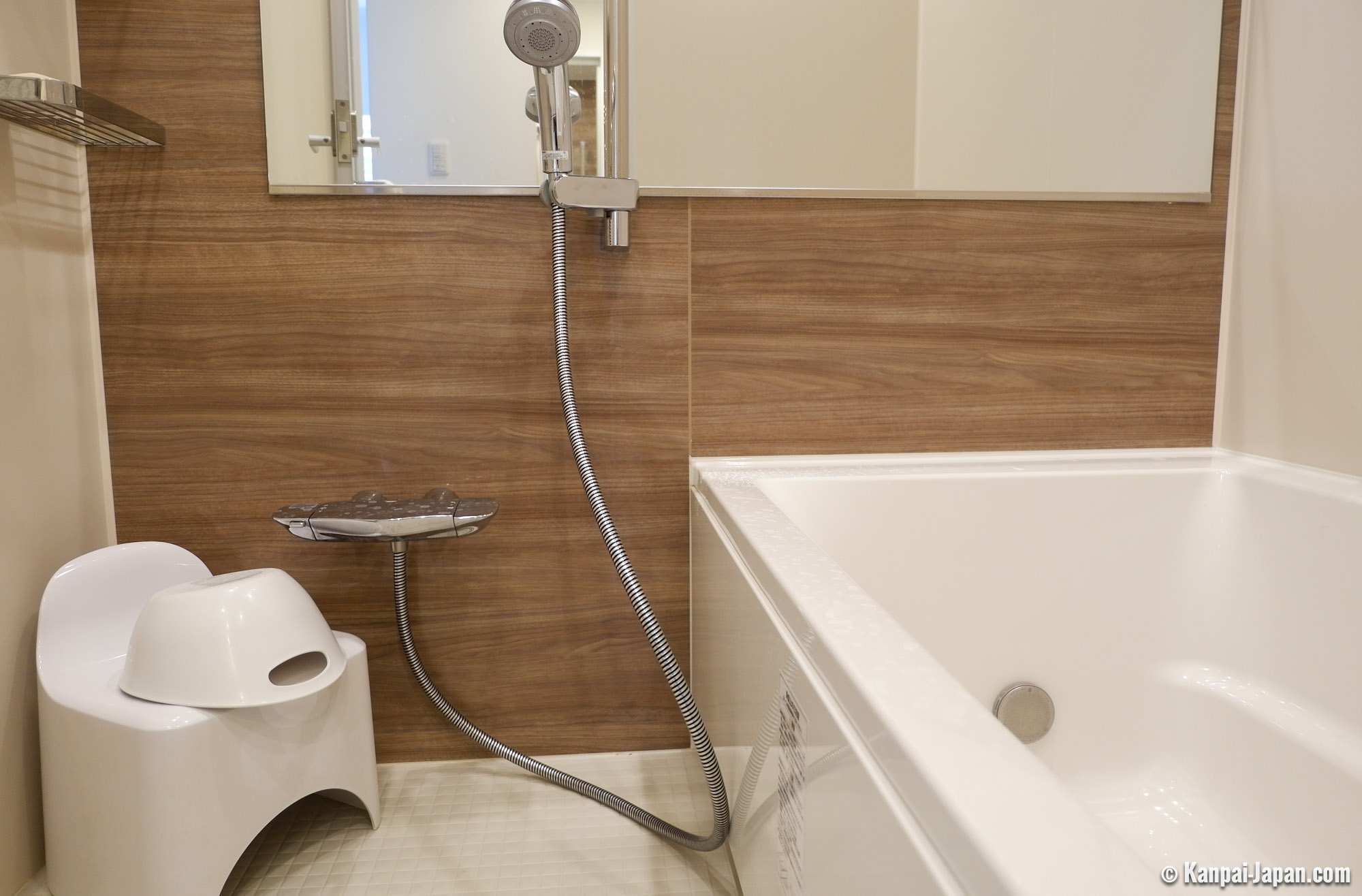Table Of Content

The meticulously arranged rocks and gravel are a nod to traditional Japanese garden design and contribute to the overall sense of harmony and balance. These elements combine to create a bathroom space that is not just functional, but also a sanctuary for relaxation and rejuvenation, deeply rooted in Japanese culture and aesthetic principles. Rather than artificial lighting, a true Japandi style maximizes natural light with large windows, further enhancing its links to the natural world. Carve out a dedicated space for relaxation and meditation within your bathroom.

Separating the tub and dressing areas create some privacy.
The shoji screens provide privacy while allowing natural light to filter through, creating a serene and calming atmosphere. In this traditional Japanese bathroom design, the deep soaking tub, known as an ofuro, serves as a focal point for relaxation and rejuvenation. Designed for complete immersion, the ofuro is a cornerstone of Japanese bathing culture and an essential element in traditional Japanese bathroom design. The subtle changes in shades are just enough to make this japanese bathroom design come to life. Central to Japanese bathing culture is the ofuro, a deep soaking tub designed for immersive relaxation.
Add texture with tiles
If you're looking to add a touch of Japandi-inspired decor to your bathroom, shop our edit below. If you ever have a chance to bring the outside in, it not only enlarges your space, but creates a breathtaking view. The all-glass wall would normally scare me, but with that view I would never get out of the shower.
Renovate to live, Sweeten to thrive!
Additionally, the toilet will always be found separate from a soaking tub. In fact, most of these bathrooms do not host a standard toilet, but instead, utilize a bidet. These features are available in a variety of colors and sizes to fit bathrooms of all types. This traditional Japanese bathroom design exemplifies the beauty and elegance of Japanese aesthetics. By incorporating natural elements, clean lines, and a deep soaking tub, the space provides a soothing and restorative retreat for the body and mind. A perfect balance of contrast with the dark floor tiles against the light concrete bath stand and countertops.
Why does this make me think of the floor is lava? Love it!
Wooden paneling offers an inviting atmosphere in a modern Japanese bath space! Wood is a popular material, used for covering the walls, ceiling, or even the floors! The traditional Japanese bathroom design in this image demonstrates the importance of creating harmony between the indoors and outdoors in Japanese aesthetics. The open-air concept and private garden view work together to establish a bathroom that is both functional and visually stunning. The rock garden in this traditional Japanese bathroom design serves as a calming focal point, encouraging mindfulness and contemplation.
Expert Tips for Blending Wood Tones to Achieve Home Harmony
Japan's Toilet Signage Goes Global Nippon.com - Nippon.com
Japan's Toilet Signage Goes Global Nippon.com.
Posted: Mon, 07 Jan 2019 08:00:00 GMT [source]
Just think minimal, calm, and organised with natural elements.In this post, I’m sharing 10 Japandi style bathrooms to help give you some inspiration for your next bathroom renovation project. I hope these Japanese bathroom ideas give you the design ideas to transform your modern bathroom, with some fantastic bathroom design ideas. They are a refuge, a place where we can relax and let our worries go, and to many of us this is why we are drawn to traditional Japanese bathroom designs.
It’s easy to see why the Japandi style is a popular design choice. Bringing together the best of Scandinavian simplicity and Japanese functionality, you’ll love this design for years to come. An architect with a penchant for history, heritage, culture, and cozy reading corners, Greeshma's aesthetic sense varies between vibrant spaces and minimalist habitats. Discreet ceiling spots with warm light, hidden lighting lines, and laconic sconces with styling in the form of cases braided with bamboo or black metal will help achieve the desired light. Designing the bathroom to have a view or access to a garden or natural scene.
The use of natural materials in this traditional Japanese bathroom design not only adds warmth and texture to the space, but also connects the room to the natural world outside. This connection to nature is an important aspect of traditional Japanese design and promotes a sense of well-being and calm. Embracing natural materials, clean lines, and a neutral color palette, Japandi transcends design trends as a timeless style.
Many Japanese bathrooms incorporate water or waterfall effects in some form. Whether arranged in a path or in pleasing designs, stones are a raw symbol of nature and can easily be incorporated into your Japanese-style bathroom. Stones make a stunning and natural backsplash for a bathroom countertop.

Typically crafted from wood such as hinoki or cedar, these tubs evoke a sense of warmth and natural beauty. Their compact size encourages a more intimate bathing experience, promoting mindfulness and contemplation. This one can be a reflection of what you can have for your small Japanese bathroom. Further, the captivating work of art starts from the wooden flooring to the soothing and straightforward bathtub comes together seamlessly to create a perfect space.
Apart from its aesthetic side, wood paneling regulates moisture, and prevents mold and mildew growth. This is really useful in a shower where moisture levels can be high! Always choose a durable water-resistant material, whenever you’re installing wooden paneling in your bathroom. Cedar, cypress, and teak are the best choices for their natural resistance to water, and moisture.
They also have Japan’s Hot Spring culture to show how Japanese people favor the activity. The culture indeed has a contrast to the western bathing culture where the Westerners take a shower to start their day. Many visitors to Japan are confused, or even a little embarrassed, by their first trip to a bathroom in Japan.
If you don’t have a Japanese heritage background, you will find the uniqueness of their bathing culture. There is also a bathing culture where a group of people bathes together as a social experience. As the recent technology is always be innovated day by day, you can also get that wonderful experience for every bath time at home.
First-time visitors to Japan may be intrigued to notice a number of specific shower tools and accessories. Though the number of accessories may seem over the top, most of them do serve a purpose in keeping the space clean and your shower safe. It’s also not uncommon to step out of the bath for a thorough, mid-soak shower, carefully keeping the suds out of the tub. When finished, the water is covered and saved for the next person. It’s entirely typical to have family members all take a soak in the same bathwater.
Love the single tone, the bowl-like bathtub and the mirror doors here. There is so much going for this design and the best part of it is that it is both space-conscious and does not appear to be trying too hard to fit in. Japanese bathrooms are designed with practicality in mind, ensuring that every element serves a purpose. Storage solutions are discreet and integrated, keeping the space clutter-free and promoting a sense of order. We believe in innovation and ongoing improvements to deliver the ultimate soaking packages for our customers.
Western homes tend to have several bathrooms, each consisting of multiple elements in a shared room. When you have the opportunity to create a Japanese-style bathroom make sure you take full advantage. If not, consider following this guide to achieve a Japanese-style bathroom. This striking timber-clad bathroom keeps things clean and uncluttered to let the gorgeous timber be the star of the show. Perfectly contrasted against the simple white fixtures this bathroom feels warm and inviting even with its minimalist design.

No comments:
Post a Comment